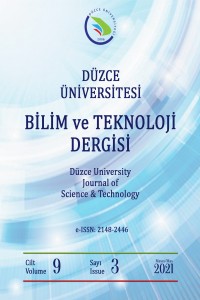Öz
Manyetik sıvı hipertermi (MFH) geliştirilmekte olan yeni nesil kanser tedavi yöntemlerinden biridir. MFH’nin pratik uygulamalarında ortaya çıkan zorluklardan biri manyetik nanoparçacıkların (MNP) sınırlı kontrolüdür. Bu sorunun üstesinden gelebilmek için MFH testlerinde yeni yaklaşımlar araştırılmaktadır. MNP salınımlarının bölgeselleştirilmesi sabit mıknatıs veya elektromıknatıslar tarafından üretilen manyetik alansız bölge (FFR) ve statik manyetik alan (SMF) gradyanları aracılığıyla sağlanabilir. Bu çalışmada elektromıknatıslara göre teknik ve ekonomik avantajlar sunmasından dolayı SMF kaynağı olarak sabit mıknatıslar tercih edilmiştir. Çalışma alanında ortaya çıkacak gradyan örüntülerini kestirebilmek için sonlu elemanlar yöntemi benzetimi kullanılmıştır. Gradyan örüntüsünün parametrik değişimlerle oluşturulacağı platform bilgisayar destekli çizim ortamında tasarlanarak 3B yazıcı ile üretilmiştir. Sabit mıknatıslarla üretilen gradyan örüntüsünün hedeflemeli MFH kullanımı için haritalanması bu çalışma ile ilk defa ele alınmıştır. Elde edilen bulgular tümör tipine göre hangi gradyan örüntüsünün kullanılabileceği hakkında bilgiler sunmaktadır.
Anahtar Kelimeler
Manyetik alan lokalizasyonu Manyetik sıvı hipertermi FEM analizi Hall effect sensor Kanser tedavileri
Kaynakça
- [1] J. Huang, X. Zhong, L. Wang, L. Yang, H. Mao, “Improving the Magnetic Resonance Imaging Contrast and Detection Methods with Engineered Magnetic Nanoparticles”, Theranostics, vol. 2, no. 1, pp. 86–102, 2012.
- [2] M. A. Busquets, J. Estelrich, M. J. Sánchez-Martín, “Nanoparticles in magnetic resonance imaging: from simple to dual contrast agents”, International Journal of Nanomedicine, p. 1727, 2015.
- [3] M. Arruebo, R. Fernández-Pacheco, M. R. Ibarra, J. Santamaría, “Magnetic nanoparticles for drug delivery”, Nano Today, vol. 2, no. 3, pp. 22–32, 2007.
- [4] S. Mura, J. Nicolas, P. Couvreur, “Stimuli-responsive nanocarriers for drug delivery”, Nature Materials, vol. 12, no. 11, pp. 991–1003, 2013.
- [5] K. Mahmoudi, A. Bouras, D. Bozec, R. Ivkov, C. Hadjipanayis, “Magnetic hyperthermia therapy for the treatment of glioblastoma: a review of the therapy’s history, efficacy and application in humans”, International Journal of Hyperthermia, vol. 34, no. 8, pp. 1316–1328, 2018.
- [6] L.Y. Zhao, J. Y. Liu, W. W. Ouyang, J. T. Tang, “Magnetic-mediated hyperthermia for cancer treatment: Research progress and clinical trials”, Chinese Physics B, vol. 22, no. 10, p. 108104, 2013.
- [7] A. E. Deatsch, B. A. Evans, “Heating efficiency in magnetic nanoparticle hyperthermia”, Journal of Magnetism and Magnetic Materials, vol. 354, pp. 163–172, 2014.
- [8] K. Murase, “A Simulation Study on the Specific Loss Power in Magnetic Hyperthermia in the Presence of a Static Magnetic Field”, Open Journal of Applied Sciences, vol. 06, no. 12, pp. 839–851, 2016.
- [9] R. Dhavalikar, C. Rinaldi, “Theoretical predictions for spatially-focused heating of magnetic nanoparticles guided by magnetic particle imaging field gradients”, Journal of Magnetism and Magnetic Materials, vol. 419, pp. 267–273, 2016.
- [10] P. Cantillon-Murphy, L. L. Wald, M. Zahn, E. Adalsteinsson, “Proposing magnetic nanoparticle hyperthermia in low-field MRI”, Concepts in Magnetic Resonance Part A, vol. 36A, no. 1, pp. 36–47, 2010.
- [11] L. M. Bauer, S. F. Situ, M. A. Griswold, A. C. S. Samia, “High-performance iron oxide nanoparticles for magnetic particle imaging – guided hyperthermia (hMPI)”, Nanoscale, vol. 8, no. 24, pp. 12162–12169, 2016.
- [12] T. O. Tasci, I. Vargel, A. Arat, E. Guzel, P. Korkusuz, E. Atalar, “Focused RF hyperthermia using magnetic fluids”, Medical Physics, vol. 36, no. 5, pp. 1906–1912, 2009.
- [13] D. Hensley, Z. W. Tay, R. Dhavalikar, B. Zheng, P. Goodwill, C. Rinaldi, S. Conolly, ‘‘Combining magnetic particle imaging and magnetic fluid hyperthermia in a theranostic platform’’, Phys. Med. Biol., vol. 62, no. 9, pp. 3483–3500, Apr. 2017.
- [14] M. Ma, Y. Zhang, X. Shen, J. Xie, Y. Li, N. Gu, “Targeted inductive heating of nanomagnets by combined AC and static magnetic field”, 2015.
- [15] K. Murase, H. Takata, Y. Takeuchi, S. Saito, “Control of the temperature rise in magnetic hyperthermia with use of an external static magnetic field”, Phys Medica. 2013; 29:624–630.
- [16] Q. Zhao, L. Wang, R. Cheng, L. Mao, R. D. Arnold, E. W. Howerth, Z. G. Chen, S. Platt, “Magnetic Nanoparticle-Based Hyperthermia for Head & Neck Cancer in Mouse Models”, Theranostics 2012, 2, 113.
- [17] E. J. Kastner, R. Reeves, W. Bennett, A. Misra, J. D. Petryk, A. A. Petryk, P. J. Hoopes, “Alternating magnetic field optimization for IONP hyperthermia cancer treatment”, Energy-based Treatment of Tissue and Assessment VIII, 2015.
- [18] H.C. Roth, A. Prams, M. Lutz, J. Ritscher, M. Raab, S. Berensmeier, “A High-Gradient Magnetic Separator for Highly Viscous Process Liquors in Industrial Biotechnology”, Chemical Engineering & Technology, vol. 39, no. 3, pp. 469–476, 2016.
- [19] A. Garraud, C. Velez, Y. Shah, N. Garraud, B. Kozissnik, E. G. Yarmola, K. D. Allen, J. Dobson, D. P. Arnold, “Investigation of the Capture of Magnetic Particles From High-Viscosity Fluids Using Permanent Magnets”, IEEE Transactions on Biomedical Engineering, vol. 63, no. 2, pp. 372–378, 2016.
- [20] W. W. Mahadi, S. Adi, K. Nor, “Application of the rare earth permanent magnet in linear generator driven by an internal combustion engine”, Proceedings. National Power Engineering Conference, 2003.
- [21] S. Erni, S. Schürle, A. Fakhraee, B. E. Kratochvil, B. J. Nelson, “Comparison, optimization, and limitations of magnetic manipulation systems”, Journal of Micro-Bio Robotics, vol. 8, no. 3-4, pp. 107–120, 2013.
- [22] Vilas-Boas, V., Carvalho, F., Espiña, B., “Magnetic Hyperthermia for Cancer Treatment: Main Parameters Affecting the Outcome of In Vitro and In Vivo Studies”, Molecules, 25(12), p.2874, 2020.
Ayrıntılar
| Birincil Dil | Türkçe |
|---|---|
| Konular | Mühendislik |
| Bölüm | Makaleler |
| Yazarlar | |
| Yayımlanma Tarihi | 29 Mayıs 2021 |
| Yayımlandığı Sayı | Yıl 2021 Cilt: 9 Sayı: 3 - Ek Sayı |


